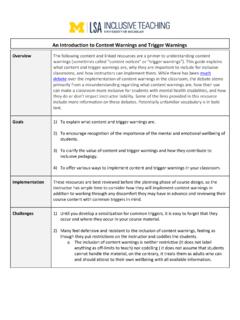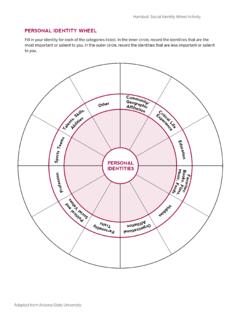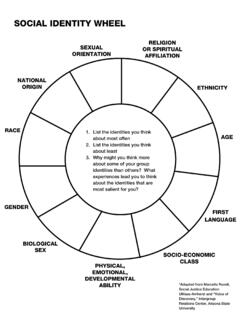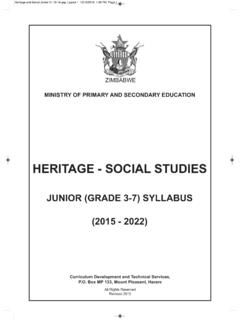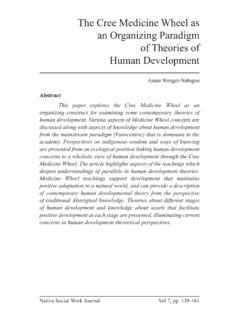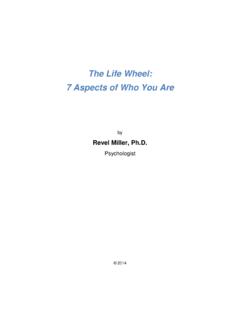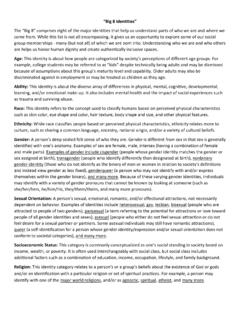Transcription of Social Identity Wheel Overview and Framing Material
1 Social Identity Wheel Adapted for use by the Program on Intergroup Relations and the Spectrum Center, University of Michigan. Resource hosted by LSA Inclusive Teaching Initiative, University of Michigan ( ). Social Identity Wheel Overview and Framing Material Overview The Social Identity Wheel worksheet is an activity that encourages students to identify and reflect on the various ways they identify socially, how those identities become visible or more keenly felt at different times, and how those identities impact the ways others perceive or treat them. The worksheet prompts students to fill in various Social identities (such as race, gender, sex, ability disability, sexual orientation, etc.) and further categorize those identities based on which matter most in their self-perception and which matter most in others perception of them. The Social Identity Wheel can be used in conjunction with the Personal Identity Wheel to encourage students to reflect on the relationships and dissonances between their personal and Social identities.
2 The wheels can be used as a prompt for small or large group discussion or reflective writing on Identity by using the Spectrum Activity Questions on Identity . Goals To encourage students to consider their identities critically and how identities are more or less keenly felt in different Social contexts. The classroom and the university can be highlighted as a context as a way to approach questions on barriers to inclusion. To illuminate how privilege operates to normalize some identities over others. For example, a student who speaks English as their first language can reflect on why they rarely need to think about their language as an aspect of their Identity while some of their peers may identify language as the aspect of their Identity they feel most keenly in the classroom. To sensitize students to their shared identities with their classmates as well as the diversity of identities in the classroom, building community and encouraging empathy.
3 Challenges The students may not perceive the activity as relevant to the course and thus may exhibit resistance. Students may not be familiar with particular concepts, or they may have different assumptions about those concepts that the activity assumes. For example, the may not know the difference between the terms sex and gender, or they may be resistant to the distinction between the two. If the Wheel is used as a discussion prompt or if students are in close quarters and are able to see what their peers have written on their worksheets, this exercise may feel especially vulnerable to students with invisible identities that they may not want to disclose to the class. Disclosure in verbal or written form should be voluntary and discussion questions should be broad enough that students can opt to not talk about more vulnerable aspects of their identities while still leaving space for them to share if they wish.
4 Other Associated Material Personal Identity Wheel Social Identity Wheel Adapted for use by the Program on Intergroup Relations and the Spectrum Center, University of Michigan. Resource hosted by LSA Inclusive Teaching Initiative, University of Michigan ( ). Spectrum Activity Questions on Identity Citations Adapted for use by the Program on Intergroup Relations and the Spectrum Center, University of Michigan. Resource hosted by LSA Inclusive Teaching Initiative, University of Michigan ( ). Social Identity Wheel (adapted from Voices of Discovery ) Image description: The chart below features a circle that is separated into 11 sections. Each section is labeled: (starting at the top and moving clockwise around the circle) ethnicity; socio-economic status; gender; sex; sexual orientation; national origin; first language; physical, emotional, developmental (dis)ability; age; religious or spiritual affiliation; race.
5 In the center of the circle, there are five numbered prompts: (1) Identities you think about most often; (2) Identities you think about least often; (3) Your own identities you would like to know more about; (4) Identities that have the strongest effect on how you perceive yourself; (5) Identities that have the greatest effect on how others perceive you. Social Identity Wheel Adapted for use by the Program on Intergroup Relations and the Spectrum Center, University of Michigan. Resource hosted by LSA Inclusive Teaching Initiative, University of Michigan ( ). Ethnicity Socio-Economic Status Gender Sex Sexual Orientation Age National Origin Race Religious or Spiritual Affiliation Physical, Emotional, Developmental (Dis)Ability First Language 1. Identities you think about most often 2. Identities you think about least often 3. Your own identities you would like to learn more about 4. Identities that have the strongest effect on how you perceive yourself 5.
6 Identities that have the greatest effect on how others perceive you



